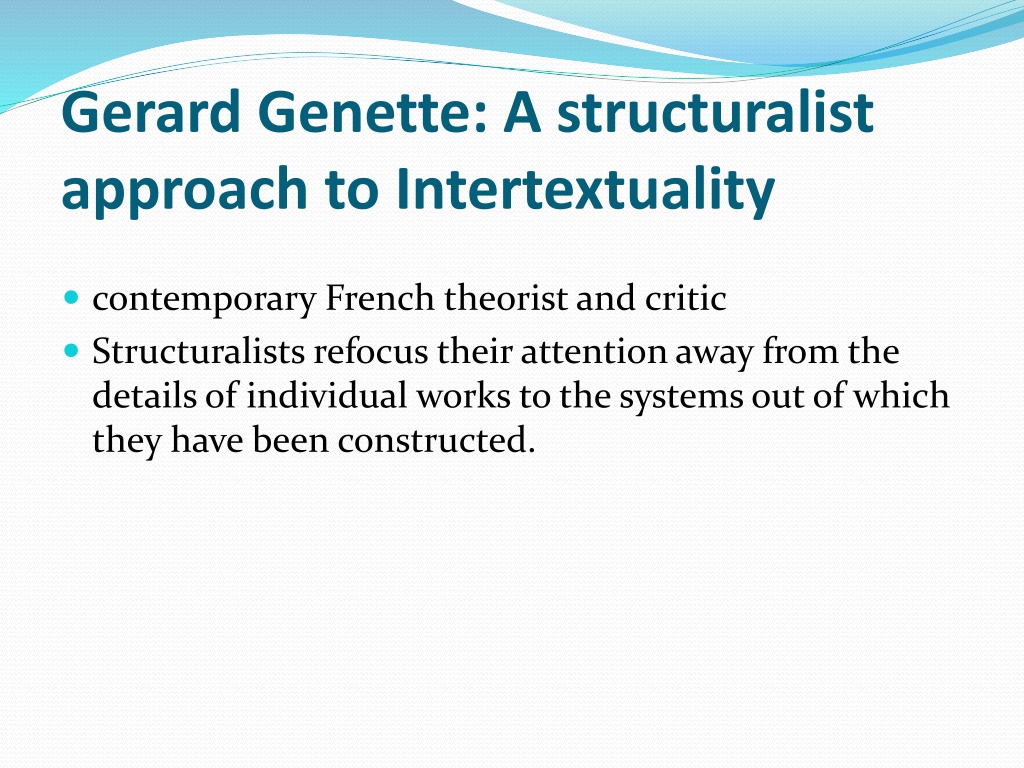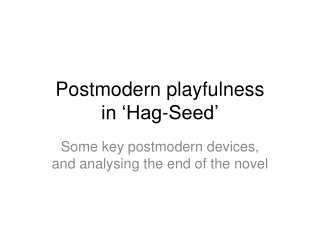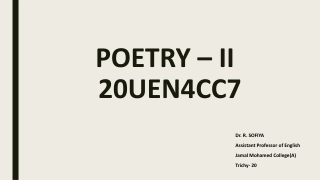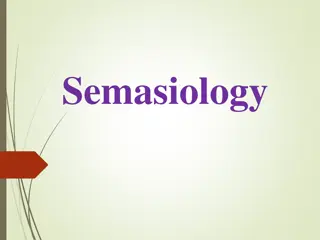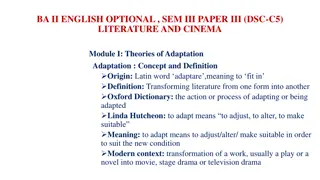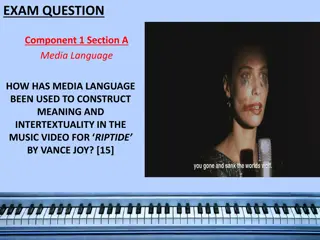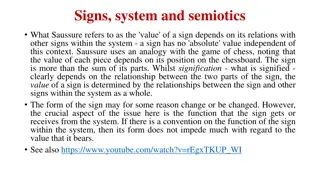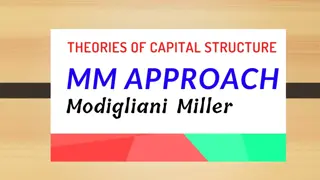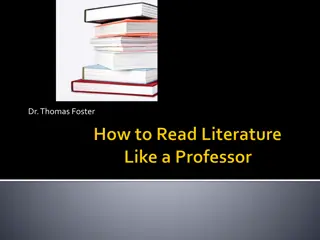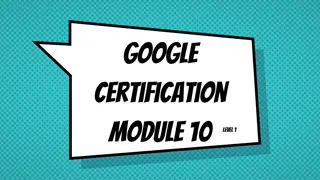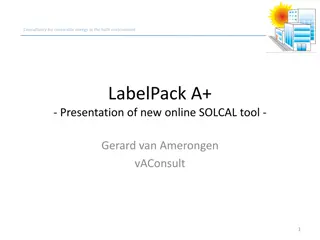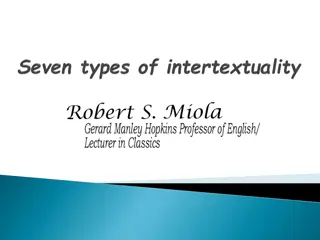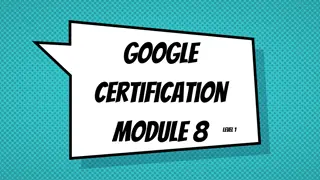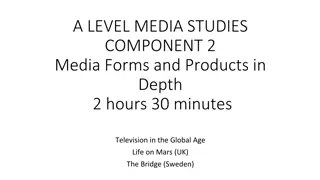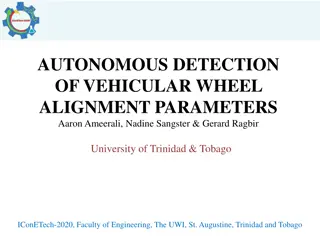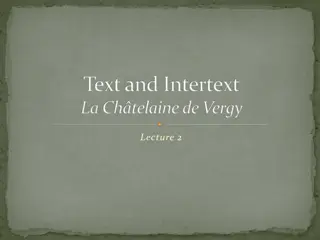Understanding Gerard Genette's Structuralist Approach to Intertextuality
Explore Gerard Genette's structuralist approach to intertextuality, where he focuses on the systems and codes within which signs and texts function rather than individual works. Genette's studies on narrative discourse and transtextuality provide a deeper understanding of how texts relate to one another through various forms of intertextuality. Learn about the five types of transtextuality and the concepts of dialogism and heteroglossia that influence Genette's theory.
Download Presentation

Please find below an Image/Link to download the presentation.
The content on the website is provided AS IS for your information and personal use only. It may not be sold, licensed, or shared on other websites without obtaining consent from the author. Download presentation by click this link. If you encounter any issues during the download, it is possible that the publisher has removed the file from their server.
E N D
Presentation Transcript
Gerard Genette: A structuralist approach to Intertextuality contemporary French theoristand critic Structuralists refocus theirattentionaway from the detailsof individual works to the systemsoutof which they have been constructed.
Genette is not concerned with individual symbolsor individual works, but with the way in which signs and texts functionwithin and are generated bydescribable systems, codes, cultural practices, and rituals.
Genette focuses the majorpartof his studieson the natureof narrativediscourseand especially narrative fiction.
. In his trilogy, composed of The Architect: An Introduction (1992), Palimpsests(a written document usually on parchment that has been written upon several times): Literature in the Second Degree (1997a), and Paratexts: Thresholds of Interpretation (1997b), Genette produces a coherent theoryand mapof what he terms transtextuality, which can be translated as a structuralistapproach to intertextuality.
5 Types of transtextuality 1- Intertextuality 2-Paratextuality 3-Metatextuality 4-Hypertextuality 5-Architextuality
Transtextuality All thatwhich putsone text in relation, whether obviousorconcealed, with other texts. Gerard Genette
Based on Mikhail Bakthin sconceptsof diagolism and heteroglossia Julia Kristeva s intertextuality : mosaicof citations thatconstitutea text.
INTERTEXTUALITY The effcetiveco-presence of two texts in the form of quotation(explicit), plagiarism orallusion(imlicit) I was surprised his nose was not growing like Pinocchio s. When she lost her job, she acted like a Scrooge, and refused to buy anything that wasn t necessary.
PARATEXTUALITY The relation between the textand its paratext (titles, prefaces, dedications ) The paratext marks theelementswhich lie on the threshold of the textand which help todirect and control the reception of a text by its readers. -para:beside
Threshold consistsof a Peritext: titles, chapter titles, prefaces and notes Epitextconsisting of elements- such as interviews, publicityannouncements, reviews byand adresses to critics, private lettersand otherauthorial and editorial discussions- outside of the text in question
The paratext performsvarious functionswhich guide the text s readers and can be understood pragmatically in termsof various simplequestions, all concerned with the mannerof the texts existence: when published? Bywhom? Forwhat purpose?
Major peritextual field Dedications Inscriptions Epigraphs Prefaces can have majoreffects upon the interpretation of a text
Genette asserts that the single most importantaspectof paratextuality is toensure for the texta destinyconsistentwith the authors purpose Function privileged at theexpense of intention
METATEXTUALITY thecritical relationship par excellence , workswhere a text makes comments aboutanother one.(commentary) Metatextual relationship can act in explaining, denying or approving of text 1. For example, different kinds of Holy Books' interpretations are interpretation, explanation and description. Metatextualityplays a significant role in establishing the "reputation" of a writer.
HYPERTEXTUALITY The relationship between one text (the hypertext) to an anterior text (hypotext), which the former transforms or modifies.(parody, sequel) A hypertext is the continuing and unconcluded meaning of its hypotext. A hypertext is the future of meaning of its hypotext. The meaning of a hypotext is incomplete without the hypertext that it generates. A hypertext and its hypotextare a sign of the past and the present as a unity of meaning. A hypertext is proof that the past is endless. Intertextuality is a sublime "conversation of time" with a distinct hint of immortality. Texts are not immortal.
Palimsests involves any relationship uniting a text B (hypertext) toan earlir textA (hypotext), upon which it is grafted in a manner that is not thatof commentary The term labeled as hypotext iss termed by mostother critics the inter-text, a textwhich can be definitely located as a majorsourceof signification of a text.
the meaning of hypertextual worksdepends upon the readers knowledgeof the hypotextwhich the hypertexteithersatirically transformsor imitates for the purposeof pastiche. Texts can be transformed by processesof self expurgation excision, reduction, amplification
Hypertext The Hours (1998) Michael Cunningham Mrs. Dalloway (1925) Virginia Woolf The Rings of Saturn (1995) W.G. Sebald Urn Burial (1685) Thomas Brown Last Orders (1996) Graham swift As I lay Dying (1931) William Faulkner Hypotext
Self expurgation: differences between the first serialized version and the final published edition of Thomas Hardy s Tess of the D Urbervilles. Excision and reduction: versions of Shakespeareor popular novels which Victorian publishers often published minus the in appropriateor religiouslycontroversial bits Amplifications: hypotextscan go through process of expansion, as in Thomas Mann s Joseph and his Brothers, which amplifiesa Biblical hypotex of approximately 26 pages toa novel of approximately 1600 pages Transmotivization: Hypertexts can givea character motivations lacking the hypotext, as in the exampleof prince of Exgypt.
Genetteseeks merely toexplore the ways in which textsare read in relation to the other texts.
ARCHITEXTUALITY Architextuality theentire set of general or transcendentcategories-typesof discourse, modesof enunciation, literary genres-from which emerges each singular text . Genettecalls architextuality, the relationship between a work and the genre that work belongs to it. Also, architextuality is the tradition or pool of texts out of which a text of the present emerges. Just as an utterance is an actual realization (parole) of the code of a language (langue), similarly any literary text originates out of a tradition of text.
paratextuality is a text in which we are influenced by items which are not in the text themselves, such as titles; metatextualitywhich is about to citing of another works texts in a different text; architextualitywhich is about a text by title; and hypertextualitywhich includes something like translation and adaptation which is limited to a text, but also to film, painting, and even music.
